Downstairs to see the vendors at 8:00, before my seminar begins at 9:00. Stenograph, my court reporting hardware and software vendor of choice, unveiled at this conference a limited-edition Diamante steno machine in “Pink Ribbon” color for breast-cancer awareness. ‹Eyes rolling› I might as well have slept in!
The business part of my trip ended just before noon. We checked out of the Hyatt Regency at 1:00 p.m. and left our bags with the bellman.
We had three hours before our visit to Alcatraz, our last stop on the San Francisco tourist trail. Until this point in our vacation, we’d been really lucky with the weather, but today it was raining. The only sight we missed due to the rain was the view from Coit Tower. Too bad, but by now we’d seen lots of great views in San Fran!
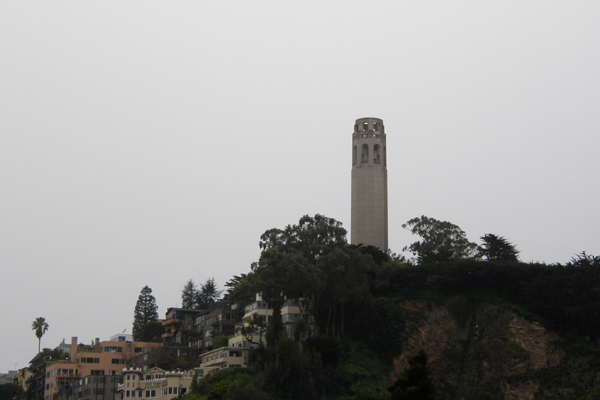
Coit Tower atop Telegraph Hill
With time for a long lunch, we went to Front Street for the third time, and today we ate at an Irish pub called The Royal Exchange. The burger and cheesesteak were good, but at six bucks apiece for the beers (and who drinks just one beer?), we spent kind of a lot of money for lunch.
We had tickets on the last ferry of the day heading to Alcatraz, on what’s called the “night tour,” leaving from Pier 33 at 4:20. We’d be on Alcatraz for sunset, to see the long shadows fall across the prison cells and to see San Francisco light up at night.
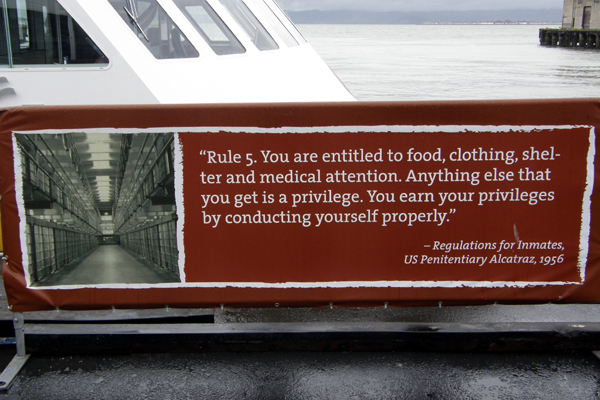
Welcome to Alcatraz
Alcatraz Island is located in the San Francisco Bay, a mile and a quarter offshore from San Francisco. It was a cold and rainy ferry ride, but the rain stopped as we arrived at the island. The dreary sky suited the gloomy atmosphere of the notorious prison island.
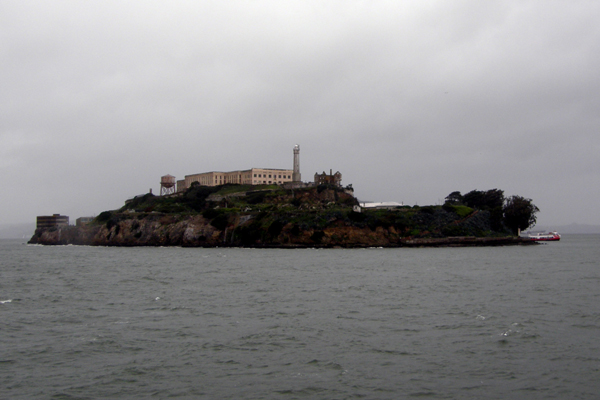
Our overcast approach
In the 1800s Alcatraz served as a defensive fort and a military prison, first housing Confederate sympathizers during the Civil War, and later general long-term military prisoners. It was deactivated as a military prison in 1933 and transferred to the civilian Bureau of Prisons.

Guard tower
Operated by the Bureau of Prisons from 1934 to 1963, “The Rock” served as a maximum-security penitentiary for such notorious prisoners as Al Capone, Robert “the Birdman” Stroud, and George “Machine Gun” Kelly. Most of the inmates were either escape risks or were considered disruptive or “incorrigible.“
The prison was smaller than I thought it would be, but just as menacing, holding an average inmate population of 260 prisoners at any given time, in cells 5-feet wide, 9-feet long, and 7-feet high.
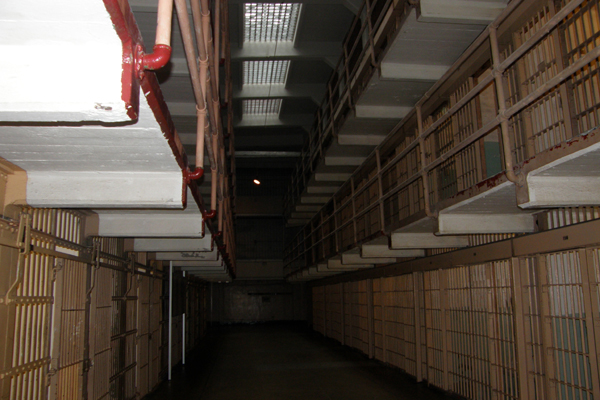
Cellhouse
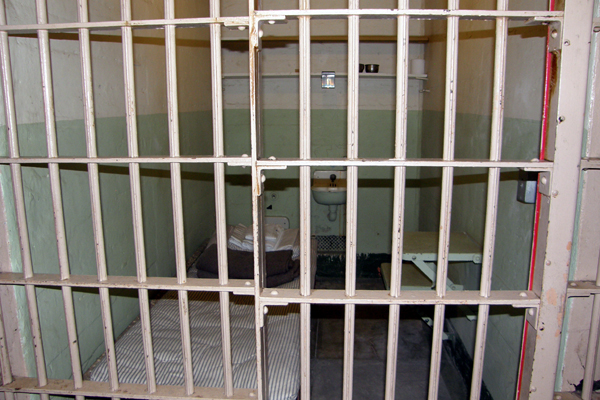
5'w x 9'l x 7'h
It cost three times more to house each prisoner on Alcatraz than in other maximum-security facilities. Sixty Bureau of Prisons families lived on the island as well, the children catching a ferry each day to the mainland to attend school. Alcatraz was closed as a prison in 1963 due to the high cost of providing food and supplies to the inmates, correctional officers, and the officers’ families.

Alcatraz Island Lighthouse
In 1969 thousands of American Indians began a 19-month occupation of Alcatraz Island, a highlight of the American Indian rights movement. Representing dozens of North American Indian nations, they called themselves “Indians of All Tribes.” The occupation eventually ended, but not before the public was awakened to the plight of the American Indians, resulting in the end of the official U.S. government policy of termination of Indian tribes. Graffiti from the time of the Indian Occupation remains on the prison walls to this day.
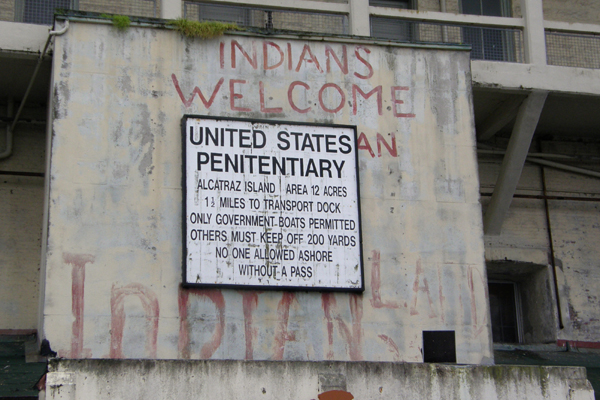
Graffiti from the Indian Occupation
In 1972 Alcatraz was designated as part of the Golden Gate National Recreation Area, managed by the National Park Service. It opened to visitors in 1973. A 45-minute audio tour guides guests through the facility. The night tour also includes presentations by the rangers only offered at night.
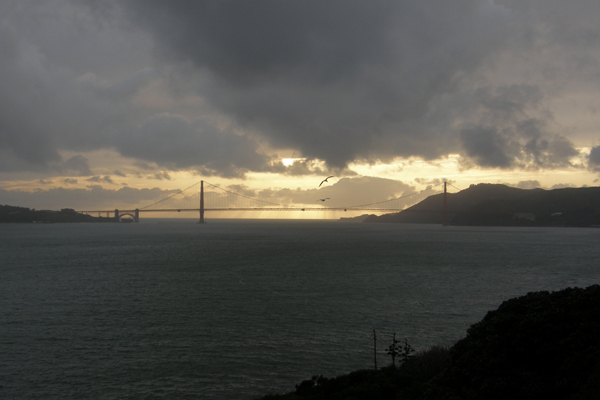
The sun sets behind the Golden Gate Bridge
The last ferry left Alcatraz at 7:15. A short time later we were back in San Francisco in the cold, damp night, with a few hours to kill before heading to the airport. Chilled to the bone, we returned to The Buena Vista for some Irish coffee. Tom and I sat at the bar and watched the bartender’s technique, and now we can make a mean Irish coffee too, though we’ve taken the liberty of substituting Kentucky bourbon for Irish whisky!
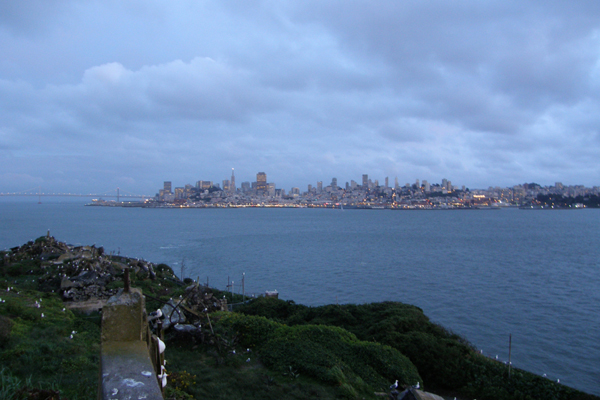
The lights of San Francisco from Alcatraz
In high spirits, we rode the Powell-Hyde and California cable cars back to the Embarcadaro and shared a sandwich at Subway. Then we picked up our luggage at the Hyatt and caught a BART train to the airport. Our plane left SFO at 1:30 a.m. Saturday, March 13. We changed planes in the wee hours of the morning in Memphis and arrived at TYS (Knoxville!) at 10:50 a.m.
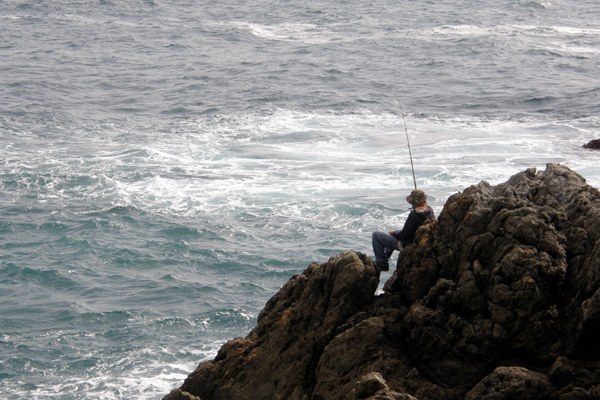
Parting shot: Partington Cove, Big Sur